Thanks to recent technological advances, different industries now have many options for metal cutting process with speed and precision. Laser, plasma, gas, and waterjet cutting are only some of these technologies. But aren’t these things just the same? And you can actually pick any of them for your project? Yes and no. That’s because while they have similarities, there are actually instances when one option is better than the other, depending on your specific needs.
If you’re on the fence about which technology is right for you, this guide can help. We’ll discuss bit by bit the major differences between these processes. So, if you’re ready to learn more and make an informed choice, read below.
How do laser, plasma, gas, and waterjet technologies work as metal cutting process?
To better understand the differences between these metal cutting process, it’ll be a good idea to learn how they work first. It would also help to look at their common applications.
1. Laser cutting
Let’s start with laser cutters. What they do is direct a high-energy light beam of a very small diameter to cut material into two-dimensional parts. And since it’s a computer-controlled manufacturing machine, laser cutting services use G-code or geometric code, a computer numerical control (CNC) programming language. It serves as an instruction that makes it possible for the light beam to melt or burn through the material to be cut in a pattern.
The common uses of this metal cutting process are sheet metal cutting, engraving, laser welding, and tube cutting.
2. Plasma cutting

This is another thermal process similar to laser cutting. But what makes plasma technology different is that instead of using a light beam to melt through materials, it utilizes a gas to send an electric arc through a nozzle, forming plasma.
An important thing to take note of about plasma cutting is that it’s more effective on electrically conductive materials. So, unlike laser, which can work on almost any material other than metal, such as wood and glass, plasma is ideally only for metals.
3. Gas cutting
How about gas cutting? Well, you can still compare it to both the laser and plasma technologies since it works almost similarly to the two thermal processes. But if you take a look at it more closely, you’ll realize that gas cutting is a more significant thermal cutting variation. Why? That’s because it now uses a combination of different gases to instigate a chemical reaction. Its main goal is to create iron oxide and then blow it away to allow the cut to continue.
Gas cutting, however, isn’t always a straightforward process. Since oxide melting levels aren’t the same across all materials, there might be an additional step needed for a chemical reaction to occur successfully. The extra work (lowering the oxide melting temperature depending on the material to be cut) can be a deterring factor for some potential users.
4. Waterjet cutting
The last on our list is waterjet cutting. This technology uses high-pressure water jets, thus, the name. The supersonic water stream, with speed faster than sound, from a small precision nozzle enables this machine to cut and shape materials to exact specifications.

Note that waterjet cutting in its pure form will only work on soft materials, such as plastics, rubber, and wood. The addition of stainless steel, glass, or titanium, though, would make cutting hard metals possible.
Hopefully, at this point, you already have an idea about the basic similarities and differences of the above-mentioned cutting technologies, especially in terms of the materials that they can cut. Now, it’s time to distinguish one from the other based on some important factors with regard to cutting in the industry context. With the help of waterjet cutters from Techni Waterjet, the cutting process becomes easier.
5. Laser vs plasma vs gas vs waterjet
To better contrast the four major cutting technologies available nowadays, let’s examine them based on the following factors:
- Maximum depth of cut: Very high-powered laser cutters could cut up to two inches (in) or 40 millimeters (mm), while a plasma cutter’s recommended cut thickness is 15 mm. On the other hand, gas has a maximum depth of cut of 250 mm (the cut edge won’t be pretty if you push it to its limits, of course), while waterjet can make cuts of up to 12 in.
Again, keep in mind that the cut’s depth will have a huge impact on the process’s performance and efficiency. - Surface finish quality: When it comes to surface finish quality, waterjet cutting reigns supreme. That’s because all the other three technologies are thermal processes that may result in heat distortion.
- Cutting speed: When working on thin sheets, laser cutters are the speed king, but plasma can overthrow it when the material’s thickness increases.
- Footprint: With technology’s advancement comes small desktop laser cutters. Can it fit on standard work desks? Well, yes. And that makes lasers the cutting technology with the smallest footprint on the list.
- Ventilation requirement: Except for waterjet, all the other cutting technologies require ventilation since they’re thermal processes. Waterjet cutters, however, need a proper drainage system instead.
- Precision: As already mentioned, waterjets’ supersonic water stream can be three times faster than sound, allowing for highly precise cutting and shaping works. And yes, it’s better than the other three technologies in this aspect.
- Operation learning curve: All of the four technologies require good CNC software and machining knowledge and skills.
- Cost: Taking into account initial, operating, and maintenance costs, plasma cutting becomes the most affordable technology while waterjet is the most expensive.

So, which do you think is the best metal cutting process based on the factors mentioned and discussed above? Of course, there’s no one-size-fits-all answer to that question, which leads us to only one conclusion.
Final verdict
It should be clear now that the right choice between the four cutting technologies depends on the specifications of the project at hand. While all types of cutters work effectively, manufacturing companies should choose based on their needs for a more seamless metal cutting process.




